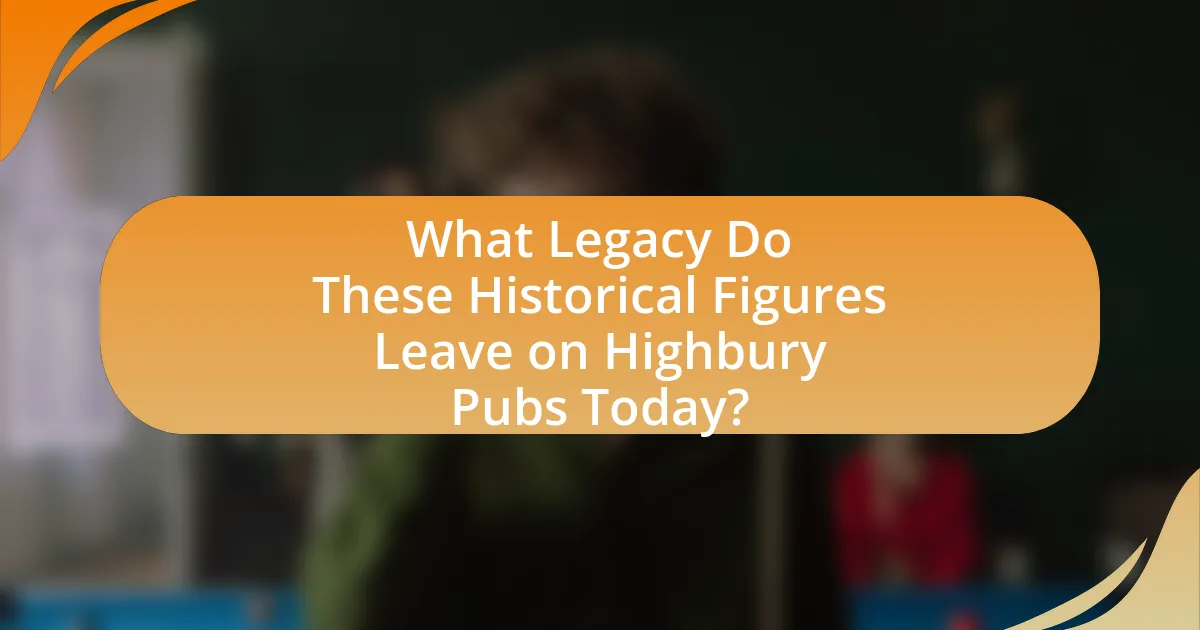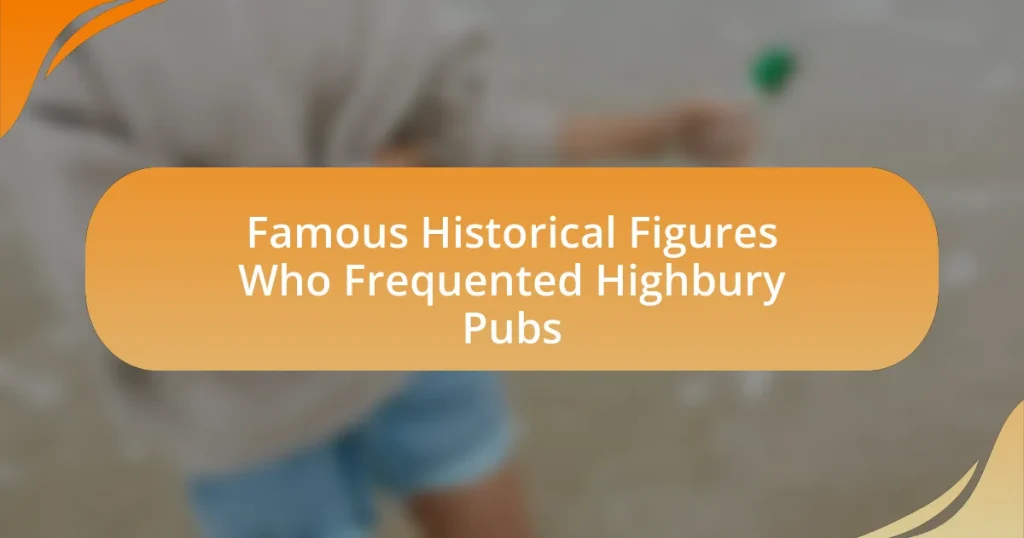The article focuses on famous historical figures who frequented Highbury pubs, highlighting notable individuals such as George Orwell, Harold Pinter, Paul Weller, and Thierry Henry. It explores the cultural and social significance of these pubs as gathering places for intellectual discourse, artistic collaboration, and community engagement during various historical periods. The piece also examines how the atmosphere of Highbury pubs influenced the lives of these figures, the legacy they left on local pub culture, and the ways in which modern patrons can connect with this rich history. Additionally, it discusses the impact of social and political contexts surrounding their visits, as well as the evolution of these establishments over time.

Who are the Famous Historical Figures Associated with Highbury Pubs?
Famous historical figures associated with Highbury pubs include George Orwell, who frequented the area during his time in London, and the playwright Harold Pinter, known for his works and contributions to British theatre. George Orwell’s connection is evidenced by his writings that reflect his experiences in London, while Harold Pinter’s presence in Highbury is noted in various biographies detailing his life and social interactions.
What notable individuals are known to have frequented Highbury pubs?
Notable individuals known to have frequented Highbury pubs include the musician and songwriter Paul Weller, who has been associated with the area. Additionally, the late footballer and manager Herbert Chapman, a significant figure in Arsenal’s history, was known to visit local pubs. These associations are supported by historical accounts and local anecdotes that highlight the cultural significance of pubs in Highbury as social hubs for prominent figures.
What are the historical backgrounds of these figures?
The historical backgrounds of the famous figures who frequented Highbury pubs include notable individuals such as George Orwell, who was a prominent writer and social critic known for his works on totalitarianism and social injustice, and who lived in the area during the 1940s. Another figure is the playwright Harold Pinter, recognized for his contributions to modern theatre and his political activism, who resided nearby and often visited local pubs for inspiration and social interaction. Additionally, the footballer Thierry Henry, celebrated for his achievements with Arsenal Football Club, has connections to Highbury, where he became a local icon. These figures are linked to Highbury through their personal and professional lives, reflecting the cultural and social dynamics of the area during their respective eras.
How did their visits to Highbury pubs influence their lives?
Their visits to Highbury pubs significantly influenced their lives by providing a social hub that fostered creativity, collaboration, and community engagement. Historical figures such as writers and artists often gathered in these establishments, leading to the exchange of ideas and inspiration that shaped their work. For instance, the vibrant atmosphere of Highbury pubs allowed individuals to network, which was crucial for their careers, as many literary and artistic movements thrived on such interactions. The pubs served as informal meeting places where discussions could lead to collaborations, ultimately impacting their contributions to culture and society.
Why did these figures choose Highbury pubs as their social venues?
These figures chose Highbury pubs as their social venues due to the area’s vibrant atmosphere and historical significance. Highbury has long been a hub for intellectual and artistic communities, attracting notable personalities who sought a lively environment for discussion and networking. The pubs in Highbury offered a blend of conviviality and cultural richness, making them ideal for social interactions among influential figures.
What social or political contexts surrounded their visits?
The visits of famous historical figures to Highbury pubs were surrounded by significant social and political contexts, particularly during the 19th and early 20th centuries. This period was marked by industrialization, social reform movements, and the rise of political activism in Britain. Notable figures, such as writers, politicians, and social reformers, frequented these establishments as they served as informal meeting places for discussing ideas and strategies related to social change, including labor rights and women’s suffrage. For instance, the Chartist movement, advocating for political reforms, gained traction during this time, and pubs became venues for organizing and rallying support. The presence of these influential individuals in Highbury pubs reflected the intersection of social life and political discourse, highlighting the role of such spaces in shaping public opinion and mobilizing communities.
How did the atmosphere of Highbury pubs appeal to them?
The atmosphere of Highbury pubs appealed to famous historical figures due to their vibrant social environment and sense of community. These establishments provided a welcoming space for intellectual discussions, camaraderie, and relaxation, which attracted notable patrons. The pubs often featured live music and local events, enhancing the lively ambiance that encouraged social interaction. This combination of a friendly atmosphere and cultural engagement made Highbury pubs a favored gathering spot for influential individuals seeking both leisure and connection.
What impact did these figures have on the culture of Highbury pubs?
The famous historical figures who frequented Highbury pubs significantly shaped the local pub culture by attracting diverse crowds and fostering a sense of community. Their presence often turned these establishments into vibrant social hubs where discussions on politics, art, and sports flourished. For instance, the frequent visits by notable personalities like writers and athletes contributed to a rich tapestry of cultural exchange, making Highbury pubs not just places for drinking but also venues for intellectual engagement and social interaction. This cultural dynamism is evidenced by the lasting popularity of these pubs, which continue to be celebrated for their historical significance and the legacy of the figures who once gathered there.
How did their presence shape the reputation of these establishments?
The presence of famous historical figures in Highbury pubs significantly enhanced the establishments’ reputations by attracting patrons and creating a sense of cultural significance. For instance, when notable writers and politicians frequented these venues, they transformed them into hubs of intellectual discourse and social interaction, thereby elevating their status within the community. This is evidenced by the historical accounts of gatherings that took place in these pubs, where influential ideas were exchanged, contributing to the local lore and drawing in visitors eager to connect with the legacy of these figures.
What stories or legends have emerged from their time at Highbury pubs?
Numerous stories and legends have emerged from the time famous historical figures spent at Highbury pubs, particularly surrounding the likes of Arsenal football players and local artists. One notable legend involves the camaraderie and rituals of Arsenal players who would gather at the Twelve Pins pub, where they reportedly shared superstitions about pre-match drinks and lucky charms. Additionally, local folklore suggests that the pub served as a meeting point for influential writers and musicians, leading to tales of creative collaborations and spontaneous performances that shaped the cultural landscape of the area. These narratives are supported by historical accounts and local anecdotes that highlight the significance of Highbury pubs as social hubs for notable personalities.

How did Highbury Pubs Reflect the Times of These Historical Figures?
Highbury pubs reflected the times of historical figures by serving as social hubs that mirrored the cultural, political, and economic climates of their eras. For instance, during the Victorian period, pubs became venues for political discourse and social reform discussions, aligning with the activities of figures like Charles Dickens, who critiqued societal issues. Additionally, the rise of the working class in the 19th century saw pubs evolve into spaces for community gathering and labor organization, reflecting the struggles and aspirations of figures such as trade union leaders. The architecture and decor of these establishments often showcased the prevailing styles and values of their time, further illustrating the connection between the pubs and the historical context of the individuals who frequented them.
What were the characteristics of Highbury pubs during their frequent visits?
Highbury pubs were characterized by their vibrant atmosphere, community engagement, and historical significance. These establishments often served as social hubs where famous historical figures gathered, fostering a sense of camaraderie among patrons. The architecture of Highbury pubs typically featured traditional designs, with wooden interiors and cozy seating arrangements that encouraged conversation. Additionally, many pubs offered a selection of local ales and traditional British fare, enhancing the cultural experience. The frequent visits by notable individuals contributed to the pubs’ reputations, making them landmarks in the area and reflecting the social dynamics of their time.
How did the design and ambiance of these pubs evolve over time?
The design and ambiance of Highbury pubs evolved significantly from the 19th century to the present day, reflecting changes in social norms and architectural trends. Initially, these pubs featured traditional Victorian designs with dark wood interiors, ornate detailing, and separate rooms for different social classes, catering to a diverse clientele, including famous historical figures. Over time, the introduction of modern materials and open-plan layouts transformed the ambiance, making pubs more accessible and inviting. By the late 20th century, many pubs adopted a more casual, contemporary style, incorporating elements like bright colors, minimalist furniture, and outdoor seating areas, which aligned with the shift towards a more relaxed drinking culture. This evolution illustrates how Highbury pubs adapted to societal changes while maintaining their role as social hubs for both locals and notable patrons.
What role did Highbury pubs play in the community during their era?
Highbury pubs served as vital social hubs in the community, fostering connections among residents and providing a space for cultural exchange. These establishments were not only venues for drinking but also centers for community gatherings, discussions, and events, reflecting the social fabric of the area. Historical records indicate that notable figures, including writers and politicians, often frequented these pubs, further enhancing their role as important meeting points for intellectual and social discourse. The presence of such influential patrons contributed to the pubs’ reputations as places where ideas were shared and community ties were strengthened.
How did the social dynamics of Highbury pubs influence historical events?
The social dynamics of Highbury pubs significantly influenced historical events by serving as informal meeting places for political discussions and social movements. These establishments provided a venue where influential figures, such as writers, politicians, and activists, could gather to exchange ideas and mobilize support for various causes. For instance, during the 19th century, pubs in Highbury became hotspots for the Chartist movement, where patrons debated reform and workers’ rights, ultimately contributing to the push for political change in Britain. The interactions and alliances formed in these pubs played a crucial role in shaping public opinion and fostering community solidarity, which were essential for the success of various historical initiatives.
What significant discussions or movements originated in these pubs?
Significant discussions and movements that originated in Highbury pubs include the early labor movement and various socialist ideologies. These pubs served as gathering places for influential figures such as trade unionists and political activists who debated and strategized on workers’ rights and social reforms. For instance, the establishment of the London Trades Council in the late 19th century was influenced by discussions held in local pubs, where activists organized efforts to improve labor conditions.
How did the interactions in Highbury pubs reflect broader societal changes?
Interactions in Highbury pubs reflected broader societal changes by serving as microcosms of evolving social norms and class dynamics. These establishments became venues where diverse groups, including working-class individuals and intellectuals, engaged in discussions that challenged traditional hierarchies and fostered a sense of community. For instance, during the 19th century, the rise of the temperance movement and the push for workers’ rights were often debated in these pubs, illustrating shifts towards greater social awareness and activism. Additionally, the presence of famous historical figures, such as writers and political activists, in Highbury pubs further highlighted the intersection of leisure and political discourse, showcasing how public spaces contributed to the democratization of ideas and the questioning of established authority.

What Legacy Do These Historical Figures Leave on Highbury Pubs Today?
Historical figures who frequented Highbury pubs leave a legacy of cultural significance and community engagement that continues to influence these establishments today. Their presence has established Highbury as a hub for social interaction, fostering a sense of local identity and camaraderie among patrons. For instance, the association of notable writers and artists with these pubs has contributed to a rich tradition of literary and artistic gatherings, which are celebrated in events and themed nights at current venues. This historical connection enhances the pubs’ appeal, drawing in visitors interested in the area’s heritage and the stories of its famous patrons.
How are these figures commemorated in Highbury pubs today?
Highbury pubs today commemorate famous historical figures through themed decor, memorabilia, and events that celebrate their contributions. For instance, pubs may display photographs, plaques, or artwork depicting these figures, creating a connection between the patrons and the area’s rich history. Additionally, some establishments host trivia nights or special events focused on the lives of these individuals, fostering community engagement and awareness of local heritage. This practice not only honors the legacy of these figures but also enhances the cultural experience for visitors and locals alike.
What events or activities celebrate their legacy in these establishments?
Events and activities that celebrate the legacy of famous historical figures in Highbury pubs include themed pub quizzes, historical reenactments, and special commemorative nights. These events often feature trivia related to the figures’ lives and contributions, attracting both locals and tourists interested in the area’s rich history. For instance, pubs may host evenings dedicated to specific figures, showcasing their impact on culture and society, thereby reinforcing the connection between the establishments and their notable patrons.
How do modern patrons connect with the history of these figures?
Modern patrons connect with the history of famous figures who frequented Highbury pubs through immersive experiences and historical narratives. These patrons often engage with the past by visiting the same establishments, where they can appreciate the ambiance and context that these figures once enjoyed. Historical records, such as pub archives and biographies, provide detailed accounts of the interactions and events that took place in these venues, allowing patrons to draw connections between their own experiences and those of historical figures. For example, the presence of notable individuals like Charles Dickens or George Orwell in these pubs is documented, enhancing the patrons’ understanding of the cultural and social dynamics of the time. This connection fosters a sense of continuity and appreciation for the historical significance of these locations.
What can visitors learn from the history of Highbury pubs and their famous patrons?
Visitors can learn about the cultural and social significance of Highbury pubs through the stories of their famous patrons. The history reveals that notable figures such as playwright George Bernard Shaw and footballer Thierry Henry frequented these establishments, highlighting the pubs as important social hubs in the community. Additionally, the evolution of these pubs reflects broader historical trends, such as the impact of the Industrial Revolution on local social life and the role of pubs in fostering artistic and sporting communities. This context provides insight into how these venues shaped local identity and social interactions over time.
What tips can be offered for exploring Highbury pubs with historical significance?
To explore Highbury pubs with historical significance, start by researching the specific pubs known for their connections to famous historical figures, such as the Highbury Barn, which was frequented by notable personalities like Charles Dickens. Next, consider visiting during guided tours that focus on the area’s rich history, as these often provide insights into the stories behind the establishments. Additionally, take time to read plaques or historical markers that detail the significance of each pub, enhancing your understanding of their cultural impact. Engaging with local historians or pub staff can also yield fascinating anecdotes and lesser-known facts about the patrons who once visited these venues.
How can understanding this history enhance the pub experience for visitors?
Understanding the history of famous historical figures who frequented Highbury pubs enhances the pub experience for visitors by providing a deeper connection to the local culture and heritage. When visitors learn about notable patrons, such as writers, politicians, or artists, they can appreciate the significance of the venue as a social and cultural hub. For instance, knowing that a renowned author once penned their work in a specific pub can create a sense of nostalgia and inspiration, enriching the overall atmosphere. This historical context transforms a simple visit into an engaging experience, allowing patrons to feel part of a larger narrative that celebrates the legacy of the community.



